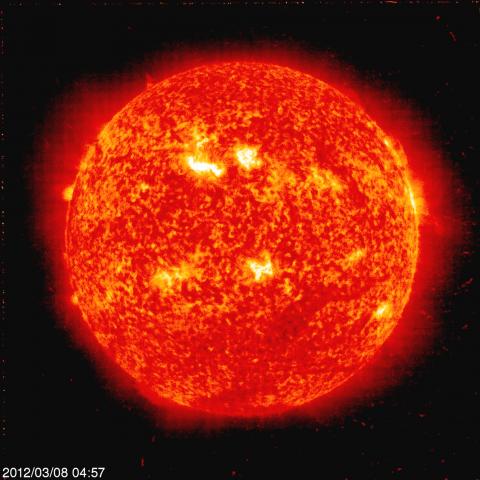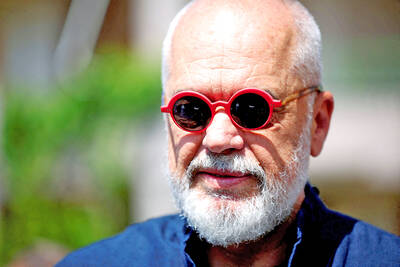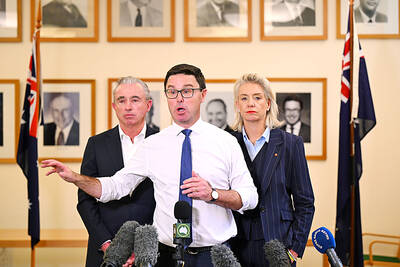One of the strongest solar storms in years engulfed Earth early on Thursday, but scientists say the planet may have lucked out.
Hours after the storm arrived, officials said there were no reports of problems with power grids, satellites or other technologies that are often disrupted by solar storms.
However, that still can change as the storm shakes the planet’s magnetic field in ways that could disrupt technology, but also spread colorful Northern Lights. Early indications show that it is about 10 times stronger than the normal solar wind that hits Earth.

Photo: Reuters
The storm started with a massive solar flare on Tuesday evening and grew as it raced outward from the sun, expanding like a giant soap bubble, scientists said.
The storm struck about 11am GMT in a direction that causes the least amount of problems, said Joe Kunches, a scientist at the National Oceanic and Atmospheric Administration’s Space Weather Prediction Center.
Initially, scientists figured the storm would be the worst since 2006, but now it seems only as bad as ones a few months ago, he said.
Forecasters can predict the speed a solar storm travels and its strength, but the north-south orientation is the wild card. And this time, Earth got dealt a good card with a northern orientation, which is “pretty benign,” Kunches said.
If it had been southern, that would have caused the most damaging technological disruption and biggest auroras.
“We’re not out of the woods,” Kunches said. “It was a good start. If I’m a power grid, I’m really happy so far.”
However, that storm orientation can and is changing, he said.
“It could flip-flop and we could end up with the strength of the storm still to come,” he said.
North American utilities so far have not reported any problems, said Kimberly Mielcarek, spokeswoman for the North American Electric Reliability Corp, a consortium of electricity grid operators.
A massive cloud of charged particles can disrupt utility grids, airline flights, satellite networks and GPS services, especially in northern areas.
The storm is part of the sun’s normal 11-year cycle, which is supposed to reach a peak next year. Solar storms don’t harm people, but they do disrupt technology. And during the last peak around 2002, experts learned that GPS was vulnerable to solar outbursts.
Because new technology has flourished since then, scientists could discover that some new systems are also at risk, said Jeffrey Hughes, director of the Center for Integrated Space Weather Modeling at Boston University.
The region of the sun that erupted can still send more blasts our way, Kunches said.
Another set of active sunspots is ready to aim at Earth.
“This is a big sun spot group, particularly nasty,” NASA solar physicist David Hathaway said. “Things are really twisted up and mixed up. It keeps flaring.”
Storms like this start with sun spots, Hathaway said.
Then comes an initial solar flare of subatomic particles that resemble a filament coming out of the sun. That part from this storm hit Earth only minutes after the initial burst, bringing radio and radiation disturbances.
After that comes the coronal mass ejection, which looks like a growing bubble and takes a few days to reach Earth.
For North America, the good part of the solar storm — the one that creates more noticeable auroras or Northern Lights — peaked on Thursday evening.
Auroras could dip as far south as the Great Lakes states or lower, Kunches said, but a full moon would make them harder to see.
Still, the potential for problems is widespread. Solar storms have three ways they can disrupt technology on Earth: with magnetic, radio and radiation emissions.
This is an unusual situation, when all three types of solar storm disruptions are likely to be strong, Kunches said.

FRAUD ALLEGED: The leader of an opposition alliance made allegations of electoral irregularities and called for a protest in Tirana as European leaders are to meet Albanian Prime Minister Edi Rama’s Socialist Party scored a large victory in parliamentary elections, securing him his fourth term, official results showed late on Tuesday. The Socialist Party won 52.1 percent of the vote on Sunday compared with 34.2 percent for an alliance of opposition parties led by his main rival Sali Berisha, according to results released by the Albanian Central Election Commission. Diaspora votes have yet to be counted, but according to initial results, Rama was also leading there. According to projections, the Socialist Party could have more lawmakers than in 2021 elections. At the time, it won 74 seats in the

A Croatian town has come up with a novel solution to solve the issue of working parents when there are no public childcare spaces available: pay grandparents to do it. Samobor, near the capital, Zagreb, has become the first in the country to run a “Grandmother-Grandfather Service,” which pays 360 euros (US$400) a month per child. The scheme allows grandparents to top up their pension, but the authorities also hope it will boost family ties and tackle social isolation as the population ages. “The benefits are multiple,” Samobor Mayor Petra Skrobot told reporters. “Pensions are rather low and for parents it is sometimes

CONTROVERSY: During the performance of Israel’s entrant Yuval Raphael’s song ‘New Day Will Rise,’ loud whistles were heard and two people tried to get on stage Austria’s JJ yesterday won the Eurovision Song Contest, with his operatic song Wasted Love triumphing at the world’s biggest live music television event. After votes from national juries around Europe and viewers from across the continent and beyond, JJ gave Austria its first victory since bearded drag performer Conchita Wurst’s 2014 triumph. After the nail-biting drama as the votes were revealed running into yesterday morning, Austria finished with 436 points, ahead of Israel — whose participation drew protests — on 357 and Estonia on 356. “Thank you to you, Europe, for making my dreams come true,” 24-year-old countertenor JJ, whose

BACKLASH: The National Party quit its decades-long partnership with the Liberal Party after their election loss to center-left Labor, which won a historic third term Australia’s National Party has split from its conservative coalition partner of more than 60 years, the Liberal Party, citing policy differences over renewable energy and after a resounding loss at a national election this month. “Its time to have a break,” Nationals leader David Littleproud told reporters yesterday. The split shows the pressure on Australia’s conservative parties after Prime Minister Anthony Albanese’s center-left Labor party won a historic second term in the May 3 election, powered by a voter backlash against US President Donald Trump’s policies. Under the long-standing partnership in state and federal politics, the Liberal and National coalition had shared power